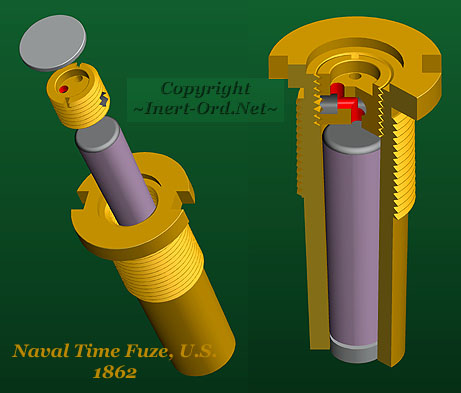
 | |
| A selection of fuzes, dating from about 1860 through W.W.I | |
|
|
|
 |
Combustion Delay Element At left is a simple combustion delay element, used during the American Civil War. It consists of a compressed column of black powder wrapped in thick paper. These were made in a variety of time delays. These examples are 5 and 10 second types. Further adjustment of the delay time would be accomplished by shortening the fuse by cutting at the appropriate mark. The term "cutting a fuse" is still in use today to describe setting the time delay of modern fuzes. This delay element would be inserted into a hollow tube of wood or metal and fixed in the nose of an artillery shell. The muzzle flash would ignite it at the moment it was fired from the gun. | ||
| The
conical shape prevented the fuze from being pushed inside the body of the
shell by the force of being fired. This design was very common
in use but varied in its performance, as the consistency of the column
of powder was difficult to control with precision, hence the actual burning
times varied. (One comment about the spelling of the term "Fuze". For proper use the word is spelled with a "Z" when describing the entire mechanical device, while "Fuse" (with an "S") is used to refer to the actual delay element. They are often used interchangeably however.) | |||
|
|
|||
 |
Naval Time Fuze This fuze, Stamped "ORD.D 1862 R" is for naval use. The brass body would hold the fuse element and a special water cap was screwed in at the top. This cap had a powder filled "lead-in" designed to allow flame to pass but not water. In the event of a low angle ricochet on the sea the fuse would continue to burn, uneffected by water spray. "ORD.D" stands for Ordnance Department. The "R" is believed to be an indicator that this fuze was removed from a live round then and used again. | ||
 |
To seal the fuze from the elements, it was closed at the top by a lead disk, (removed before firing) and at the base with a lead plug. The base plug acted as a safety as well, preventing an explosion if the fuse was accidentally ignited. It would remain in position even if the shell were dropped, but would be forced out of the tube at the moment of firing, clearing the path for the combustion train. Different time delays could be used as required by the gunner. Here you can see the zig-zag path of the lead-in, shown in red. | ||
|
|
|||
| Schenkl Percussion (Impact) Fuze One of the most significant advantages of rifled cannon was the ability to develop an artillery round that would detonate reliably on impact. With un-stabilized shells fired from smoothbore artillery, there was no practical solution. A fuze which functioned well on impact, was also inclined to detonate at the moment of firing. With the advent of rifled guns, where the projectile traveled nose first, the solution was much simpler. | |||

|
|||
 |
The Schenkl percussion fuze, patented in 1861 was quite successful and remained in naval use
long after the Civil War. The hollow brass tube contains a plunger held in place by a small screw. On discharge from the piece,
the screw would break and the plunger was free to move. On impact the percussion cap, slamming forward,
would fire, ignite the primer within the plunger and explode the shell. Note the recess in the small screw cap. For shipping this cap is installed with that recess facing inside. This is a safe condition. Just prior to use this top cap is unscrewed, flipped over and screwed back in place. The other side, with its flat surface, now acts as an anvil for the primer to hit. | ||
| In this example you can also see the use of a booster component at the
base of the fuze. This is the beginning of the graded detonation technique for artillery.
The main filling is made of a very stable explosive, for safety reasons. The initial fuze element is a very sensitive component
which sets off a series of increasingly larger explosive charges leading eventually to the main charge.
This allows safer manufacturing and transport, where the relatively small fuze is installed just prior to use. | |||
|
|
|||
| French Time & Percussion "Beehive" Fuze |
||
 |
||
 |
This is an early combination of combustion time and impact fuze design, developed by the French. Formally identified as 24/31mm Mod.1915 but commonly referred to as a "Beehive" fuze due to its characteristic shape. Originally developed in 1889, these can be found is a variety of sizes and lengths. They were used on 75mm and larger projectiles and used through the end of WWI and after. As the range of artillery increased, much longer delays time fuzes were neccessary than could be provided by earlier designs such as the 5 second Bormann time fuze. This design takes the idea of a simple crescent shaped delay train, and continues that vertically in a helical path. The delay is contained in a lead tube and the brass fuze body covers it. Holes in the fuze, marked with the delay time, allow a punch to be pushed into the delay tube, exposing the powder at that point. These examples are 22 second types. When fired from the gun, an internal igniter creates a flash igniting the fuze train at the point it was punched. The delay burns down to a lead-in to the detonator. If the shell hits before the delay completes its burn, a back-up impact fuze explodes the shell. | |
| 04.11.05 |